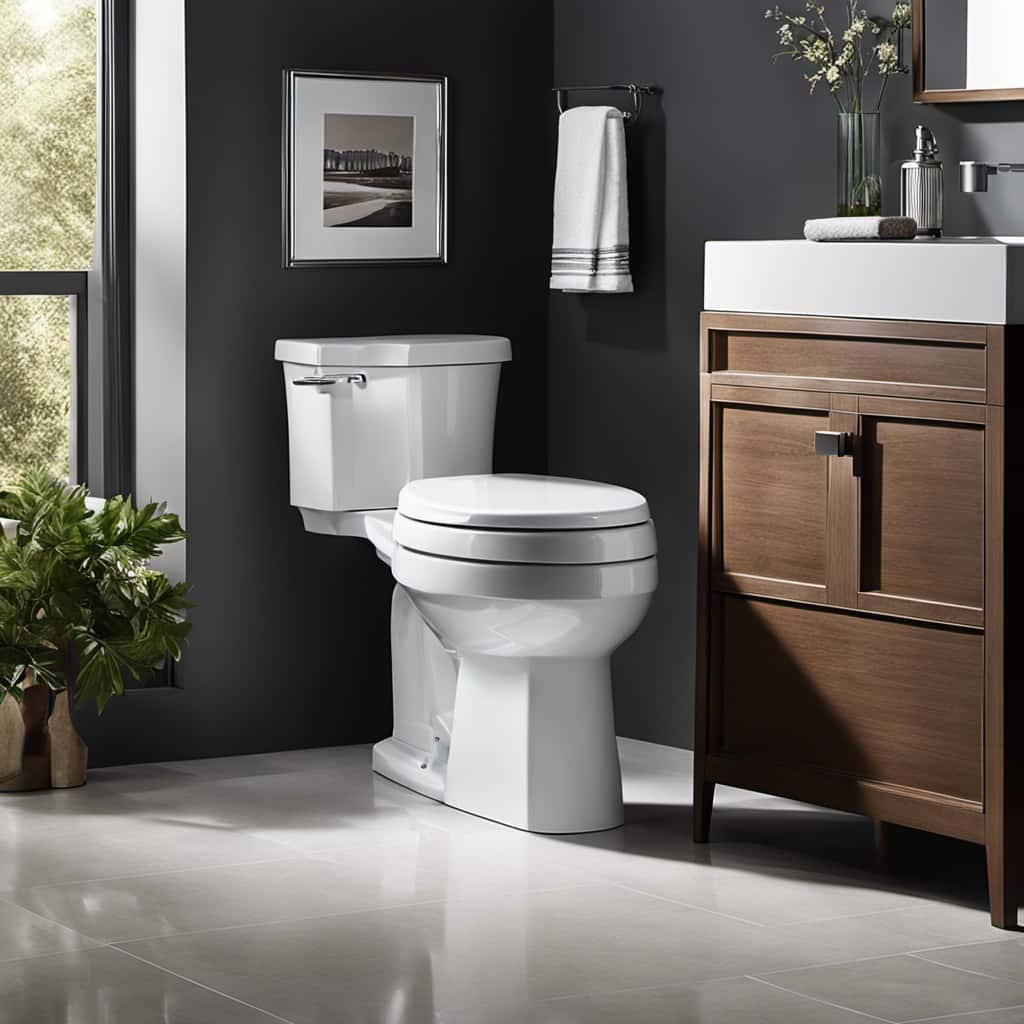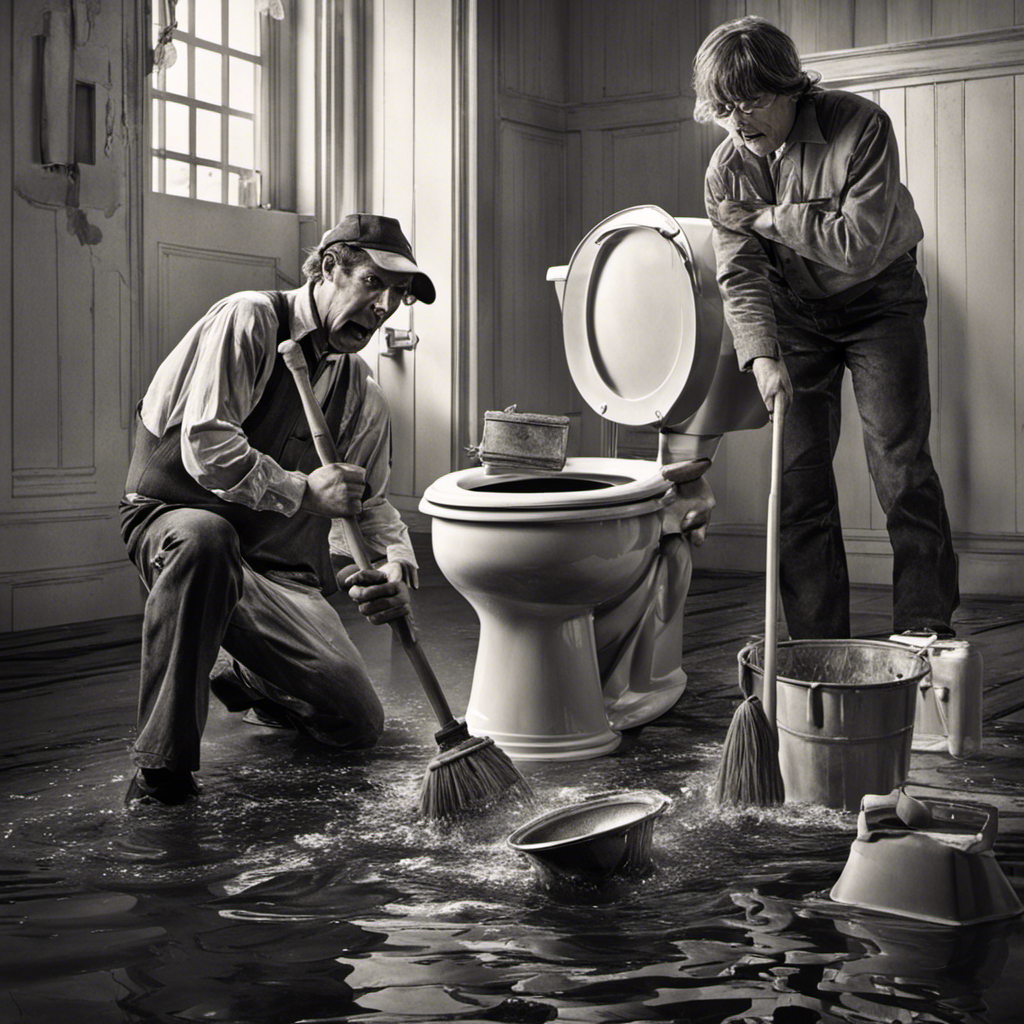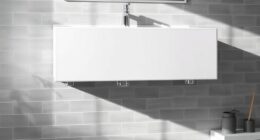Ever pondered the reason behind your toilet’s melodic flush? Look no further, as we have the explanations you’ve been seeking.
Did you know that water pressure and flow issues can cause this strange phenomenon? It’s true!
In this article, we will explore all the possible causes and solutions, from faulty fill valves to clogged pipes.
So, if you’re ready to master the art of toilet troubleshooting, let’s dive in and uncover the secrets behind your singing toilet.

Key Takeaways
- Water hammer can cause a singing sound when flushing and can be resolved by installing water hammer arrestors.
- Sediment buildup in pipes can affect water flow and pressure, leading to the singing sound. Regularly cleaning the toilet’s pipes can prevent this issue.
- Faulty fill valve can cause the singing sound. Check for obstructions, replace if necessary, and ensure proper adjustment to the recommended water level.
- Problems with the flush valve such as water leaks or reduced flushing efficiency can contribute to the singing sound. Promptly address these issues to maintain proper toilet functionality.
Water Pressure and Flow Issues
We often experience water pressure and flow issues in our toilets, which can result in a singing sound when we flush.
One common issue that causes this is known as water hammer. Water hammer occurs when the flow of water is abruptly stopped or changed direction, causing a sudden increase in pressure. This increase in pressure can create vibrations in the pipes, leading to the singing sound.
Another potential cause is sediment buildup. Over time, minerals and debris can accumulate in the pipes, causing restrictions in the water flow and affecting the pressure. This can also contribute to the singing sound when flushing.
To resolve these issues, it’s important to address any water hammer problems by installing water hammer arrestors. Additionally, regularly cleaning the toilet’s pipes can help prevent sediment buildup.

Faulty Fill Valve
To address the singing sound when flushing, it’s crucial to explore the possibility of a faulty fill valve. The fill valve is responsible for regulating the water supply to the toilet tank after each flush. If it’s malfunctioning, it can cause the singing sound. Here are four key factors to consider when dealing with a faulty fill valve:
- Water supply: Check if there are any obstructions or restrictions in the water supply line leading to the fill valve. Ensure that the water pressure is adequate for proper functioning.
- Valve replacement: If the fill valve is old or worn out, it may need to be replaced. Look for a compatible replacement valve and follow the manufacturer’s instructions for installation.
- Proper adjustment: Ensure that the fill valve is properly adjusted to the recommended water level. This can help prevent any unnecessary noise during flushing.
- Professional assistance: If you’re unsure about the cause or solution for the faulty fill valve, it’s recommended to seek the help of a professional plumber who can diagnose and fix the issue accurately.
Problems With the Flush Valve
Moving on from the previous subtopic of a faulty fill valve, let’s now delve into the problems that can arise with the flush valve. The flush valve is responsible for releasing a powerful surge of water to efficiently flush waste down the drain. However, over time, the flush valve can develop issues that affect its performance. One common problem is water leaks, which can lead to wasted water and higher utility bills. Another issue is reduced flushing efficiency, where the valve fails to release an adequate amount of water, resulting in incomplete flushes. To give you a better understanding, here is a table summarizing the problems with the flush valve:
| Flush Valve Problems | Causes | Solutions |
|---|---|---|
| Water leaks | – Worn-out flapper |
- Loose valve seal
- Cracked valve body | – Replace the flapper
- Tighten the valve seal
- Replace the valve body |
| Reduced flushing efficiency | – Clogged valve - Low water pressure
- Malfunctioning flush handle | – Clean or replace the valve
- Increase water pressure
- Repair or replace the flush handle |
With these potential issues in mind, it is crucial to address any problems with the flush valve promptly to ensure proper toilet functionality. Now, let’s move on to the next section, where we will discuss clogged or partially blocked pipes and their impact on toilet performance.
Clogged or Partially Blocked Pipes
Continuing our exploration of toilet malfunctions, let’s now turn our attention to the issue of clogged or partially blocked pipes. This problem can lead to a variety of unpleasant consequences, including slow drainage, backups, and even overflowing toilets.

To prevent clogs and ensure proper plumbing maintenance, it’s important to follow these steps:
- Use a drain strainer: Placing a strainer over your drain can catch hair, debris, and other potential clog-causing materials.
- Avoid flushing non-flushable items: Items like sanitary pads, wipes, and cotton balls should never be flushed down the toilet as they can easily clog the pipes.
- Regularly clean your pipes: By using natural drain cleaners or a mixture of baking soda and vinegar, you can keep your pipes clear of buildup and prevent clogs.
- Schedule professional inspections: Regular maintenance by a professional plumber can help identify and resolve any potential pipe blockages before they become major issues.
Improperly Installed or Worn Out Flapper
Our toilet’s singing when we flush could be due to an improperly installed or worn out flapper. The flapper is a rubber seal that regulates the flow of water from the tank into the bowl. If it isn’t installed correctly or has deteriorated over time, it can cause a variety of issues, including the singing sound.
To address this problem, you may need to consider a toilet flapper replacement. When choosing a replacement flapper, ensure that it’s compatible with your toilet model and size.
Additionally, regular flapper maintenance is essential to prevent future problems. Some flapper maintenance tips include cleaning the flapper regularly, checking for any signs of wear and tear, and adjusting the chain length for proper seal operation.

Malfunctioning Ballcock
When dealing with a malfunctioning ballcock in a toilet, there are a few key points to consider.
Firstly, a noisy flushing mechanism can be a sign of a faulty ballcock, causing vibrations and a singing sound during flushing.
Secondly, a malfunctioning ballcock can also result in water level issues, such as constantly running water or insufficient filling of the tank.
To address these problems, potential repair solutions include adjusting the ballcock’s height, replacing the float, or replacing the entire ballcock assembly if necessary.

Noisy Flushing Mechanism
Sometimes, we experience a noisy flushing mechanism in our toilets due to a malfunctioning ballcock. This can be quite frustrating, but luckily, there are a few possible solutions to address this issue:
- Check for water hammer: Water hammer occurs when the water flow is abruptly stopped, causing a loud banging noise. To prevent this, you can install a water hammer arrestor near the shut-off valve.
- Inspect the ballcock: The ballcock is responsible for regulating the water level in the toilet tank. If it’s not functioning properly, it can cause noise during flushing. Ensure that the ballcock is adjusted correctly and free from debris.
- Consider toilet tank insulation: Adding insulation to the toilet tank can help reduce noise caused by vibrations. Insulating materials, such as foam or rubber, can be placed on the inside of the tank to minimize sound.
- Seek professional assistance: If the noise persists or you’re unsure about the cause, it’s best to consult a plumber who can diagnose and fix the issue.
Water Level Issues
To address water level issues caused by a malfunctioning ballcock, we need to examine its functionality and make necessary adjustments.
The ballcock, also known as the fill valve, controls the water level in the toilet tank. If the water level is too high or too low, it can cause problems such as inefficient flushing or constant running.
To adjust the water level, locate the adjustment screw on the ballcock and turn it clockwise to lower the water level or counterclockwise to raise it.

If this doesn’t resolve the issue, there may be a problem with the ballcock itself, such as a worn-out washer or float. Troubleshooting tips include checking for any leaks or blockages in the valve and cleaning or replacing any worn-out parts.
By properly adjusting the water level and troubleshooting the ballcock, you can ensure optimal toilet performance.
Now, let’s explore possible repair solutions to address these water level issues.
Possible Repair Solutions
How can we effectively address a malfunctioning ballcock in order to repair the singing toilet? Here are some possible repair solutions to troubleshoot water pressure issues and fix the toilet fill valve:

- Check water pressure: Ensure that the water pressure coming into the toilet is within the recommended range. High or low water pressure can cause problems with the ballcock. Use a pressure gauge to measure the water pressure.
- Adjust water level: If the ballcock isn’t shutting off properly, it may be due to an incorrect water level. Adjust the water level by turning the adjustment screw on the ballcock. This will help regulate the flow of water and prevent the singing sound.
- Clean or replace the ballcock: Over time, sediment or debris can accumulate in the ballcock, affecting its functionality. Clean the ballcock thoroughly or replace it if necessary.
- Seek professional help: If the above solutions don’t resolve the issue, it may be best to consult a professional plumber. They can diagnose the problem accurately and provide the necessary repairs.
Loose or Damaged Toilet Parts
We noticed that our toilet was singing when we flushed, and upon investigation, we discovered loose or damaged toilet parts. Loose or damaged parts can lead to water leakage and even toilet bowl cracks if left unaddressed.
When a toilet is flushed, water flows from the tank into the bowl through a series of interconnected components. If any of these components are loose or damaged, they may not function properly, causing the singing sound. Common culprits include loose flush valves, damaged fill valves, or worn-out flapper seals.
To fix the issue, it’s important to identify the specific part causing the problem and replace it as needed. Regular inspection and maintenance can help prevent these issues and ensure the proper functioning of your toilet.
Air Pressure Imbalances
Air pressure imbalances can be a common cause of the singing noise when flushing a toilet. These imbalances occur when there’s a difference in the air pressure inside and outside the toilet bowl.

One technique to reduce the noise caused by air pressure imbalances is to install an anti-siphon fill valve. This valve helps regulate the pressure and prevent the singing sound.
Causes of Imbalance
One possible cause of imbalance when flushing a toilet is the presence of a blocked or restricted air passageway. This can result in a variety of issues, including water hammer and toilet gurgling. Here are four potential reasons for air pressure imbalances:
- Clogged Vent Pipe: A vent pipe is responsible for releasing air from the plumbing system. If this pipe becomes blocked by debris or buildup, air pressure imbalances may occur.
- Faulty Air Admittance Valve: An air admittance valve allows air to enter the plumbing system, preventing negative pressure buildup. If this valve malfunctions or is blocked, imbalances can arise.
- Improperly Designed Plumbing System: A poorly designed plumbing system can lead to inadequate venting, causing air pressure problems during flushing.
- Obstructed Toilet Trap: The toilet trap, which prevents sewer gases from entering the bathroom, can become clogged with debris. This obstruction can disrupt the normal flow of air and water, leading to imbalances.
Understanding these potential causes of air pressure imbalances can help in diagnosing and resolving issues with your toilet.
Noise Reduction Techniques
To reduce noise caused by air pressure imbalances, we can implement various techniques. One effective method is to use water saving techniques, such as installing a low-flow toilet. These toilets use less water per flush, resulting in reduced pressure imbalances and consequently less noise. Another option is to employ soundproofing methods, such as insulating the walls around the toilet or using acoustic panels. These materials can absorb and dampen the sound waves, minimizing the noise generated during flushing. Additionally, adjusting the water pressure can help alleviate air pressure imbalances and reduce noise. By implementing these noise reduction techniques, we can create a quieter and more comfortable bathroom environment.

| Water Saving Techniques | Soundproofing Methods |
|---|---|
| Low-flow toilets | Insulating walls |
| Adjusting water pressure | Acoustic panels |
Vibrations From Loose Water Supply Connections
When it comes to the issue of vibrations from loose water supply connections, we’ve noticed a common problem that can cause your toilet to sing when you flush. These vibrations are often caused by a phenomenon known as water hammer, which occurs when the flow of water is suddenly stopped or redirected. Loose water supply connections can exacerbate this issue, causing the pipes to vibrate and produce the singing sound.
To address this problem, it’s essential to perform regular plumbing maintenance. Here are four steps you can take to prevent vibrations from loose water supply connections:
- Check for any loose or worn-out connections. Tighten them if necessary or replace them if they’re damaged.
- Inspect the water supply lines for any signs of leaks or corrosion. Address any issues promptly to prevent further damage.
- Consider installing water hammer arrestors. These devices absorb the shock caused by sudden water flow changes, reducing vibrations.
- Consult a professional plumber if the problem persists. They can assess the situation and provide expert advice on resolving the issue.
Resonance and Acoustic Effects
To understand the phenomenon of resonance and its acoustic effects on toilets, we need to delve into the interaction between the water flow and the structural components of the toilet system.
When the water flows into the toilet tank and is subsequently released during a flush, it creates vibrations that can resonate within the toilet bowl and other parts of the system. These vibrations can produce audible sounds, giving rise to the musicality of the toilet’s flush.

The resonance occurs when the frequency of the water flow matches the natural frequency of the toilet system, causing the components to vibrate sympathetically. Factors such as the size and shape of the bowl, the material of the toilet, and the water pressure can all influence the resonance and resulting acoustic effects.
Understanding these principles can help in addressing and mitigating any unwanted singing or excessive noise during flushing.
Other Possible Causes and Solutions
One possible cause of a singing toilet can be attributed to issues with the toilet’s fill valve. If the water pressure is too high, it can cause a loud noise when the toilet is flushed. To troubleshoot this issue, consider adjusting the water pressure by turning the shut-off valve clockwise to decrease the flow.
Another possible cause of the noise could be a faulty or worn-out fill valve. In this case, replacing the fill valve with a new one can help reduce the noise.

Additionally, installing a pressure-reducing valve in the water supply line can regulate the water pressure and minimize the noise during flushing.
Lastly, using noise-reducing fill valves or toilet fill valve repair kits can also help in reducing the noise during toilet flushing.
Conclusion
In conclusion, the singing toilet phenomenon can be caused by various factors such as:
- Water pressure and flow issues
- Faulty fill or flush valves
- Clogged pipes
- Worn-out flappers
- Air pressure imbalances
- Loose water supply connections
- Resonance and acoustic effects
Troubleshooting these problems and addressing them promptly can help silence your toilet’s unexpected serenade, ensuring a peaceful bathroom experience.

Like a chorus of birds singing in harmony, a well-functioning toilet should bring joy and tranquility to your daily routine.










